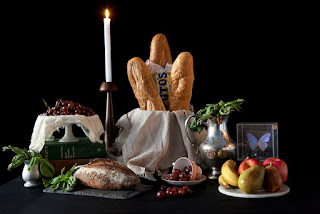 Podophobia is defined as a persistent, irrational fear of feet (podos "feet" + phobia "fear). For some, their podophobia means they will not touch their own feet. For some, the sight of any feet is disturbing. Some do not want anyone else to look at their feet. Bringing good news or not, those feet would not be appreciated.
Podophobia is defined as a persistent, irrational fear of feet (podos "feet" + phobia "fear). For some, their podophobia means they will not touch their own feet. For some, the sight of any feet is disturbing. Some do not want anyone else to look at their feet. Bringing good news or not, those feet would not be appreciated. My day job is teaching high school art. In the classroom next to mine, my colleague has beginning art students do a graphite drawing either of their hands or of their feet. The year when "feet" are in the syllabus results in many more comments by students. The students are "creeped out" by feet as they (or the photography students in my class) take photos of their feet to serve as reference photos (left above). One family has had multiple children in that beginning art class during "foot year". We've suggested they should frame and hang all the feet drawings as some kind of weird family portrait.
My day job is teaching high school art. In the classroom next to mine, my colleague has beginning art students do a graphite drawing either of their hands or of their feet. The year when "feet" are in the syllabus results in many more comments by students. The students are "creeped out" by feet as they (or the photography students in my class) take photos of their feet to serve as reference photos (left above). One family has had multiple children in that beginning art class during "foot year". We've suggested they should frame and hang all the feet drawings as some kind of weird family portrait.My teaching colleague knows what Albrecht Durer knew: hands and feet are demanding subjects for students, but they are also subjects that are very helpful as students are learning to draw. While podophobes (and beginning art students) may be "creeped out" by feet, Leonardo da Vinci is credited with describing the human foot as a masterpiece of engineering and a work of art.
Durer's study of two feet (left bottom) is a study for a now-missing altarpiece. In an interesting intersection, these feet will become the feet of Paul. Durer has made the feet of Paul into a work of art. Perhaps Paul's math would say that engineering + art + good news = beautiful.
(Bottom) Albrecht Durer. Study of Two Feet For the Apostle Paul in the Heller Altarpiece. c. 1508. Brush and grey ink, grey wash, heightened with white, on green prepared paper, Museum Boijmans Van Beuningen, Rotterdam, Netherlands.





